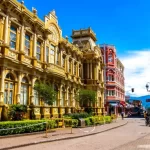Violent Colombia vs. Peaceful Costa Rica
In the last two years about 25 Americans that I know have moved from Costa Rica to Medellín, Colombia. You are probably asking why?
There are two main reasons for them relocating. First, the cost of living in Medellín seems to be about 30 percent less than Costa Rica. Most of those who moved there are living on pensions and wanted to get more “bang for their buck.” For detailed information about the cost of living in Medellín see: https://www.numbeo.com/cost-of-living/in/Medellin
Second, the majority of those who relocated are single men who spend a lot of time pursuing women. No need to elaborate on this subject. I think readers can see between the lines.
Medellín’s spring-like climate is definitely not the deciding factor since Costa Rica’s Central Valley has even better weather with not as much pollution from automobiles. Medellín is located in a deeper valley making it difficult for the smog to dissipate. The times I have visited, there appears to be an inversion layer making it seem extremely polluted. Briefly, inversion is defined as a layer of the atmosphere in which there is a temperature inversion, with the layer tending to prevent the air below it from rising, thus trapping any pollutants that are present.

One thing is for sure, since 1948 Costa Rica has virtually been at peace whereas Colombia (Medellín included) has been engaged in one violent conflict after another. Let’s look at Costa Rica first, since it’s recent history is less complicated and convoluted than both Colombia’s past and present. In 1948 Costa Rica officially abolished its military. Since it achieved this historic feat, it seems to suit its people just fine. The country has been ranked first in Latin America and 12th in world in happiness, according to the 2017 World Happiness Index. The Happy Planet Index also ranked it No. 1 in the world.
Costa Rica leads the Latin American and Caribbean region in health and primary education, having the second lowest infant mortality rate after Chile and a 98 percent literacy rate, according to the 2016-17 Global Competitiveness Report. The country also provides universal health care to its citizens and permanent residents. The World Health Organization ranks Costa Rica as having the best health care system in Central America and 36th best in the world.
On the other hand, Colombia’s last 70 years have been a totally different story. Besides having an enduring history of conflict between the country’s liberals and conservatives, the year 1948 seemed to be start of what seems to be a never ending spiral of endemic violence. In 1948 Liberal Party leader Eliécer Gaitán was shot to death. Gaitán represented hope and a new beginning for Colombia’s people. His death marked the beginning of years of violence. Liberals blamed the conservatives for the assassination, so liberals began to kill conservatives. This era is sadly referred to as La Violencia or “The Violence” in English. As a result during this twenty-year conflict between between 100,000 and 200,000 people died. Colombian history is full of feuds that last for generations. It seems that Colombians have never been able to heal their societal wounds. All of this mess was fueled by the inequity that still exists between the social classes. This is exemplified by Colombia’s even stratified social system that ranks neighborhoods according to wealth.
Unfortunately, new forms of violence came about after La Violencia. Because of the country’s gap between the haves and have nots continued to grow, in starting in the 1960s Intellectuals, angry campesinos (peasants), dissidents and students took up arms. Leftist guerrilla groups like the FARC, ELN and M-19 emerged because of the discontent. To further compound matters, right-wing paramilitary groups were born and the result was an undeclared civil war which is still going on today with ELN and FARC splinter groups still operating. At its peak the FARC alone had almost 20,000 fighters. They eventually made peace with the Colombian government but the accord is very controversial since many Colombians do not agree with it since it lets many former guerrilla leaders off the hook for the crimes they committed.
Along the way the illegal right-wing paramilitary groups committed terrible atrocities including wiping out of entire towns. Fortunately, most of these paramilitary groups were demobilized in the first decade of this century but the effects of the genocide these groups committed still linger. The Justice and Peace Law of 2005, which disbanded the paramilitary, has bees been criticized for being too lenient and giving outright amnesty to criminals who perpetrated horrendous crimes against humanity.
The emergence of Medellín’s Pablo Escobar in the 1980s added to the country’s bloodbath. In 1989 Forbes magazine considered Escobar to be the seventh richest man on the planet. Escobar and others turned Colombia into the Cocaine capital of the world and Medellín became the world’s murder capital ( about 400 per 100,000) as a result. As Time magazine called it, “The most dangerous city in the whole world.”
Cable cars, metro system and other improvements have contributed to Medellín’s recent success. The city has experienced a renaissance and was voted “The Come Back City of the Year.” However, despite this turn around over the last two decades, social inequalities and other issues still plague the city. Drug trafficking still exists — last year was bumper crop in Colombia. The city has approximately 240 different gangs with an estimated 5,000 members. The number of homicides in Medellin have increased after hitting an all-time low in 2015. The current murder rate is around 25 per 100,000 inhabitants. Although Costa Rica’s homicide rate has increased in recent years, it hovers only around 12 per 100,000 inhabitants for the whole country. One thing rarely seen in Costa Rica are metal reinforced security doors. From what I understand most apartments and homes in Medellín have them. Hmmmmmmm
Bottom line: Currently Medellín is very popular with expats and offers a high quality lifestyle. I have been there many times and have enjoyed every visit. The restaurants, culture and entertainment are hard to beat. Most of the Americans and Canadians I have met there seem to be very happy. The city is definitely my second choice for living after Costa Rica.. However, there is not enough there to make me move from here where I have family, friends and a successful relocation/retirement business. interestingly, I am in the process of starting a similar type relocation business in Medellín to take advantage of the burgeoning interest. ( see http://www.liveincolombia.com/)
.
The only thing that is unsettling are the country’s underlying social problems and historical tendency towards extreme violence, especially over the last 70 years, making it the complete opposite of Costa Rica.



